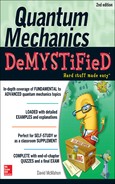
Introduction
Quantum mechanics, which by its very nature is highly mathematical (and therefore extremely abstract), is one of the most difficult areas of physics to master. In these pages we hope to help pierce the veil of obscurity by demonstrating, with explicit examples, how to do quantum mechanics. This book is divided into three main parts.
After a brief historical review, we cover the basics of quantum theory from the perspective of wave mechanics. This includes a discussion of the wavefunction, the probability interpretation, operators, and the Schrödinger equation. We then consider simple one-dimensional scattering and bound state problems.
In the second part of the book we cover the mathematical foundations needed to do quantum mechanics from a more modern perspective. We review the necessary elements of matrix mechanics and linear algebra, such as finding eigenvalues and eigenvectors, computing the trace of a matrix, and finding out if a matrix is Hermitian or unitary. We then cover Dirac notation and Hilbert spaces. The postulates of quantum mechanics are then formalized and illustrated with examples. In the chapters that cover these topics, we attempt to “demystify” quantum mechanics by providing a large number of solved examples.
The final part of the book provides an illustration of the mathematical foundations of quantum theory with three important cases that are typically taught in a first semester course: angular momentum and spin, the harmonic oscillator, and an introduction to the physics of the hydrogen atom. Other topics covered at some level with examples include the density operator, the Bloch vector, and two-state systems.
Unfortunately, due to the large amount of space that explicitly solved examples from quantum mechanics require, it is not possible to include everything about the theory in a volume of this size. However, in this second expanded edition we have added many topics included in the second semester of a typical quantum mechanics course. These topics include the treatment of identical particles; introducing the notion of fermions and bosons, which is a prerequisite for understanding fundamental particle physics; and the division between matter- and force-carrying particles. We also consider an important topic called perturbation theory. This includes mathematical techniques used to derive approximate solutions for problems which otherwise could not be solved. We explore the application of perturbation theory to the hydrogen atom revealing new physics, showing the power of these techniques.
Other topics discussed in the new chapters include time-dependent perturbation theory, where we learn how to handle time-dependent Hamiltonians and the important problem of scattering.
There is no getting around the mathematical background necessary to learn quantum mechanics. The reader should know calculus, how to solve ordinary and partial differential equations, and have some exposure to matrices/linear algebra and at least a basic working knowledge of complex numbers and vectors. Some knowledge of basic probability is also helpful. While this mathematical background is extensive, it is our hope that the book will help “demystify” quantum theory for those who are interested in self-study or for those from different backgrounds such as chemistry, computer science, or engineering, who would like to learn something about quantum mechanics.
David McMahon
..................Content has been hidden....................
You can't read the all page of ebook, please click here login for view all page.
